Gregory A. Fournier's Blog, page 19
August 10, 2018
The Outrage and the Nature of Truth
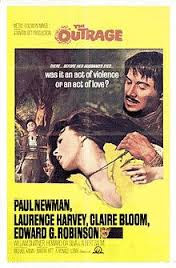
One of Paul Newman's least known and seldom shown films is The Outrage (1964). The film explores the elusive nature of truth as five conflicting versions of the same crime are presented to a frontier judge before a burned out courthouse. The film is an adaptation of Japanese director Akira Kurosawa's Rashomon (1950).
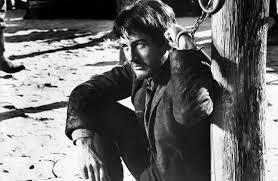 Newman plays the unlikely role of Juan Carrasco, a Mexican outlaw accused of raping a Southern belle and killing her aristocratic husband. The beguiling Claire Bloom plays the violated woman, and Laurence Harvey plays her Southern gentleman. Despite the lurid subject matter, Newman, Bloom, and Harvey give tongue and cheek performances in episodic flashbacks which entertain in unexpected ways.
Newman plays the unlikely role of Juan Carrasco, a Mexican outlaw accused of raping a Southern belle and killing her aristocratic husband. The beguiling Claire Bloom plays the violated woman, and Laurence Harvey plays her Southern gentleman. Despite the lurid subject matter, Newman, Bloom, and Harvey give tongue and cheek performances in episodic flashbacks which entertain in unexpected ways. 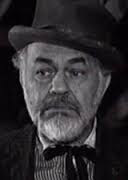 Rounding out the cast is Edward G. Robinson as a cynical, larcenous gambler. His performance may be one of his best as he shines throughout the film. William Shatner plays a frontier preacher who has lost his faith after he hears the conflicting trial testimony. His performance is subdued and pensive making Robinson's portrayal of the sleazy conman all the more compelling. Howard Da Silva plays a down-on-his-luck prospector undergoing a moral crisis. He has withheld important evidence by not testifying at the trial.
Rounding out the cast is Edward G. Robinson as a cynical, larcenous gambler. His performance may be one of his best as he shines throughout the film. William Shatner plays a frontier preacher who has lost his faith after he hears the conflicting trial testimony. His performance is subdued and pensive making Robinson's portrayal of the sleazy conman all the more compelling. Howard Da Silva plays a down-on-his-luck prospector undergoing a moral crisis. He has withheld important evidence by not testifying at the trial.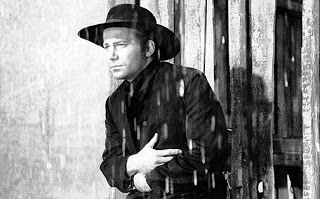 The three men are waiting overnight in a rundown train depot for the next train out of town. A driving rainstorm sets the somber tone for the movie. As the three men discuss the Carrasco case, director Martin Ritt intersperses flashbacks depicting the various points-of-view which have as much to do with the truth as the basic facts of the case.
The three men are waiting overnight in a rundown train depot for the next train out of town. A driving rainstorm sets the somber tone for the movie. As the three men discuss the Carrasco case, director Martin Ritt intersperses flashbacks depicting the various points-of-view which have as much to do with the truth as the basic facts of the case. The Outrage is a provocative and thought-provoking movie filmed in the Sonoran Desert near Tucson, Arizona. Every Paul Newman fan should see this film at least once.
Trailer for The Outrage: https://www.youtube.com/watch?v=zt9xrEjQZPg
Published on August 10, 2018 11:33
August 7, 2018
Canadian Prohibition Loophole Fuels Roaring Twenties in United States
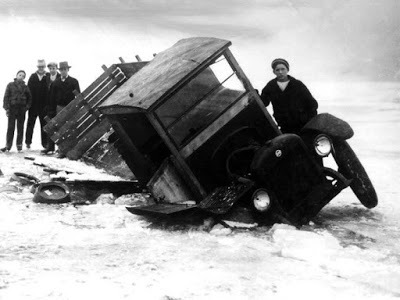 Model T stake truck breaks through Detroit River ice with overload of Canadian liquor
Model T stake truck breaks through Detroit River ice with overload of Canadian liquorDuring the United States Prohibition period, the majority of liquor passing through Windsor, Ontario and the Border Cities into the United States came across the Detroit River. The United States Customs Department estimates that 80% of all illegal spirits brought into the country during Prohibition originated in Canada--our neighbor to the North. This "Detroit Funnel" as it became known in the press supplied liquor to Chicago, Lansing, Toledo, Cleveland, St. Louis, Kansas City and all points in between.
When Ontario passed the Ontario Temperance Act in 1916, the province closed the bars, clubs, and liquor stores until the end of World War I. The government needed the grain for the war effort. But with the end of the war, the Canadian government repealed wartime Prohibition and liquor began to flow again in the Dominion.
 Meanwhile, the United States Congress passed the 18th Amendment--otherwise known as the Volstead Act--on October 28, 1919. The act banned the manufacture, transport, sale, import, export, and delivery of alcohol spirits within its borders. The bootlegger, rum runner, and flapper were born. The easy market and close access to Detroit became the focal point for shipping illegal booze into the United States from Canada. Historians labeled the age The Roaring Twenties--when organized crime flourished on both sides of the International Border.
Meanwhile, the United States Congress passed the 18th Amendment--otherwise known as the Volstead Act--on October 28, 1919. The act banned the manufacture, transport, sale, import, export, and delivery of alcohol spirits within its borders. The bootlegger, rum runner, and flapper were born. The easy market and close access to Detroit became the focal point for shipping illegal booze into the United States from Canada. Historians labeled the age The Roaring Twenties--when organized crime flourished on both sides of the International Border. Under pressure from vocal Temperence groups on both sides of the International Border, Ottawa passed Bill 26 decreeing that each province could prevent the importation of liquor by holding a referendum vote. The rest of Canada voted dry leaving Ontario to stand alone. The province did vote to approve the Sandy Bill on July 19, 1921 which disallowed the movement of liquor within Ontario without an order of the Board of License Commissioners.
Jim Cooper--Belle River and Walkerville roadhouse owner and illicit liquor dealer--figured out that if he set up an export business in Detroit, he could circumvent the Ontario law. Canadians would place an order through a Detroit telephone number. The purchased goods were not imported into Ontario. The liquor was already in Windsor and Walkerville warehouses. Because the purchase was made out of the country, it was perfectly legal to be delivered within Ontario.
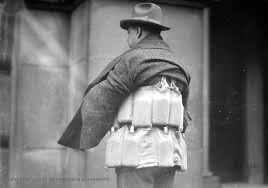 During Prohibition, six distilleries and twenty-nine brewers operated within Ontario all licensed by the federal government. It is estimated that forty million dollars of booze illegally crossed the border every year. At first, there was a lot of small-time suitcase smuggling for personal use. All manner of devices were contrived to conceal bottles. Some people strapped bottles under their clothing, pints were slid into high boots, and cars were fitted with hidden compartments.
During Prohibition, six distilleries and twenty-nine brewers operated within Ontario all licensed by the federal government. It is estimated that forty million dollars of booze illegally crossed the border every year. At first, there was a lot of small-time suitcase smuggling for personal use. All manner of devices were contrived to conceal bottles. Some people strapped bottles under their clothing, pints were slid into high boots, and cars were fitted with hidden compartments.After organized crime wrestled control of the river from small-time operators, much of the liquor was smuggled in by the boat load. In the winter, old jalopies, trucks, and sleds scurried across the frozen river to engage in the illegal trade. When the U.S. Coast Guard built up their fleet with 200 h.p. patrol boats hoping to dominate the river traffic, the Purple Gang's Little Jewish Navy bought specially outfitted speed boats and mounted small cannons on their bows with Tommy Gun-toting crews to harass the authorities leveling the playing field. The Purple Gang laid claim to the Detroit River as their territory. Any freelance bootleggers unlucky enough to be caught smuggling by the gang lost their booty and often their lives. The Purple Gang alone is credited by police with the murder of over 500 people during their bloody reign of the Detroit underworld.
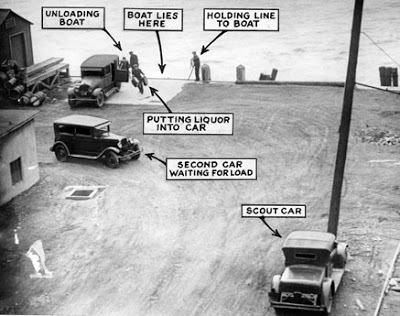
Earning the big money became possible because of a gaping loophole in the Canadian law. Large quantities of liquor could be bought from Canadian distilleries for export purposes if purchasers or their agents carried a Canadian Customs B-13 export clearance document certifying that the buyer was exporting liquor anywhere but a country where Prohibition was the law. Shipments were marked for Europe, Cuba, and South America. But once a boat left the loading dock, the Canadian government was unconcerned where it actually moored and unloaded. The burden of enforcing this American law fell squarely upon the United States, and the Dominion felt no obligation to enforce the laws of their sovereign neighbor.
The boxes and barrels of liquor were distributed to Ontario Border City export docks strung out along the length of the Detroit River. Rum runners from Detroit would cruise across, load up their boats, and make their river runs--mostly at night. In the winter, the shipments were loaded on the frozen Canadian river bank awaiting their mass exodus across the International Border.
Some of the diverted illegal liquor stayed in Canada by sailing directly into slips behind Ontatio's chain of roadhouses stretching from Windsor to Niagara Falls offering dining, drinking, dancing, gambling, and adult entertainment. Americans flocked to Ontario to patronize the Border Cities thriving vice economies.
For its part, the Canadian Government levied a nine dollar tax per gallon on all liquor sales. This export tax was returned when the customs department received a certificated receipt from the country where the shipment was imported. Since most of the liquor landed in America, those receipts were never redeemed. By 1928, Canada earned up to thirty-million dollars per year this way.
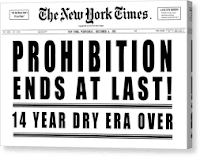 With the New York stock market crash on October 29, 1929 and the onset of the Great Depression, many people lost everything. Jobs were scarce and money was tight. The drunken revel was all but over. Then on December 5, 1933, the United States government passed the 21st Amendment repealing Prohibition. The bill landed on President Franklin Delano Roosevelt's desk and he signed it. The boom times of Prohibition ended on both sides of the international border. It would take another World War to turn the economies around for both countries.
With the New York stock market crash on October 29, 1929 and the onset of the Great Depression, many people lost everything. Jobs were scarce and money was tight. The drunken revel was all but over. Then on December 5, 1933, the United States government passed the 21st Amendment repealing Prohibition. The bill landed on President Franklin Delano Roosevelt's desk and he signed it. The boom times of Prohibition ended on both sides of the international border. It would take another World War to turn the economies around for both countries.The Rise and Fall of the Purple Gang:
https://fornology.blogspot.com/2018/03/the-rise-and-fall-of-detroits-purple.html
Published on August 07, 2018 09:30
July 27, 2018
Richard Streicher Jr. School Friend Makes Unexpected Appearance
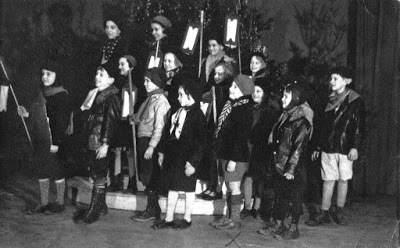 December 1934 Fresh Air School Christmas assembly. Richard Streicher Jr. is in first row marked with an X and Paul Woodside is in the second row behind him. Richard had only ten weeks to live.
December 1934 Fresh Air School Christmas assembly. Richard Streicher Jr. is in first row marked with an X and Paul Woodside is in the second row behind him. Richard had only ten weeks to live. On March 7, 1935--the day seven-year-old Richard Streicher Jr. went missing--his friend Paul Woodside walked home from school with him. Both boys were enrolled in a special education program called the Fresh Air School at Welsh Hall on the campus of the Michigan State Normal College (now Eastern Michigan University) in Ypsilanti.
The History of Special Education at Eastern Michigan University mentions the program as for "children of low vitality." These students had various health or orthopedic conditions which were accommodated in this setting. Woodside suggested in an April 23, 2007 interview with Ypsilanti Historical Society docents George Ridenour and Lyle McDermott that he thought Richie Streicher may have had a heart or blood-pressure problem or perhaps he was hyperactive.
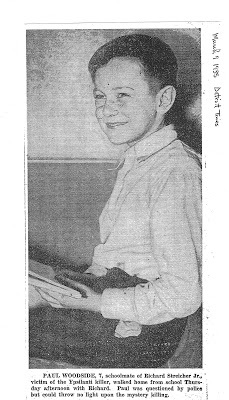 Woodside recounted how he was awakened by his parents the day after his friend's body was found frozen under the Frog Island Bridge. The Ypsilanti Police wanted to interview him, but he knew nothing about Richie's disappearance.
Woodside recounted how he was awakened by his parents the day after his friend's body was found frozen under the Frog Island Bridge. The Ypsilanti Police wanted to interview him, but he knew nothing about Richie's disappearance.Paul said he liked going to Richie's apartment to play with his toys--many of which he and other kids couldn't afford during lean Depression times. Paul remembered Richie's grandparents giving their grandson a pedal-powered motor car but couldn't recollect anything about Richie's parents.
Eighty-year-old Woodside said he thinks of Richie often. "I sometimes wish I could go to bed at night and dream what happened and see who did this. Why would someone do this to a seven-year-old kid? Especially so close to his house. Did Richie see something he shouldn't have seen? How could someone kill him on such a busy, well-lighted street?"
These questions have haunted Paul Woodside for over seven decades. After the original news reports of the crime, Woodside said he never heard anything else about the murder. He was unaware that Richie's body was exhumed ten months after his death and that Richie was reburied in an unmarked grave in Highland Cemetery.
While signing copies of The Richard Streicher Jr. Murder: Ypsilanti's Depot Town Mystery at the Ypsilanti Historical Museum on July 12, 2018, I was about to leave when ninety-one-year-old Paul Woodside walked through the door. He rushed over from an appointment in Ann Arbor and was afraid he would miss the book signing. I was fortunate my signing went past four o'clock, so I didn't miss meeting and speaking with Paul. He was interested in my true crime treatment of what happened to his friend eighty-three years before.
Paul is the only person I have interviewed who actually knew Richie Streicher. I asked him what Richie was like.
 Paul Woodside and I at the Ypsilanti Historical Society Archives--July 12, 2018.
Paul Woodside and I at the Ypsilanti Historical Society Archives--July 12, 2018. "(Richie) was a very friendly, likeable kid who was well-behaved and somewhat shy, but he enjoyed school life and playing with friends, and he was smart."
"Did he ever talk about his mom and dad with you?"
"No, we were just kids who liked playing together and didn't talk about adults."
Then the conversation turned to Paul Woodside's family roots in the Ypsilanti area which stretch back at least five generations. If you grew up in Ypsi, you probably know a Woodside or two.
For locals, copies of the Streicher book are available at the Ypsilanti Historical Society on 220 North Huron Street in their basement archives. All proceeds go to the society.
A paperback edition and all five ebook formats are available at http://www.amazon.com/Gregory-A.-Fournier/e/B00BDNEG1C
Published on July 27, 2018 09:11
July 5, 2018
Detroit Festival of Books Is Just Around the Corner

Take Interstate 94 to Russell St. exit (216A). Go south for a few blocks. Ample parking nearby.
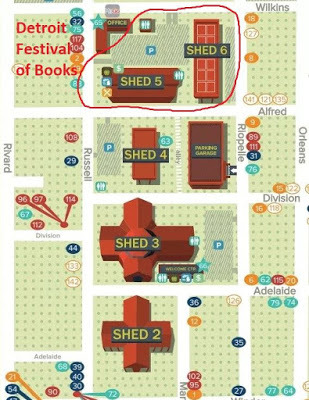
For information about my books, check out my author site at www.gregoryafournier.com
Published on July 05, 2018 08:44
July 1, 2018
White Castle Rules!
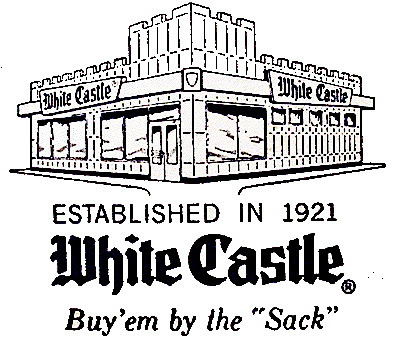 One of my guilty pleasures when flying into Detroit is stopping at the White Castle on Telegraph Road and Northline. My favorite item is the #2 combo--two double-cheese burgers and fries with a medium soft drink. The family-owned chain services the Midwest and Mid-Atlantic states, so most of the country is unaware of this delectable taste treat.
One of my guilty pleasures when flying into Detroit is stopping at the White Castle on Telegraph Road and Northline. My favorite item is the #2 combo--two double-cheese burgers and fries with a medium soft drink. The family-owned chain services the Midwest and Mid-Atlantic states, so most of the country is unaware of this delectable taste treat. White Castle sliderTheir signature product consists of a thin square of 100% ground beef with five steam holes punched into it. The patty is cooked on a bed of diced onions and topped with a steamed hamburger bun, dressed with dill pickles, mustard and ketchup, and served up in a cardboard sleeve. One food critic called it "French onion soup on a bun." To be honest, either you love them or you hate them.
White Castle sliderTheir signature product consists of a thin square of 100% ground beef with five steam holes punched into it. The patty is cooked on a bed of diced onions and topped with a steamed hamburger bun, dressed with dill pickles, mustard and ketchup, and served up in a cardboard sleeve. One food critic called it "French onion soup on a bun." To be honest, either you love them or you hate them.Walter A. Anderson began his restaurant career working at food stands in Wichita, Kansas. In 1916, he bought an obsolete streetcar and converted it into a diner. He had opened two more diners by the time he met businessman Edgar Wolds "Billy" Ingram and co-founded the first White Castle restaurant on an original investment of $700 in 1921.
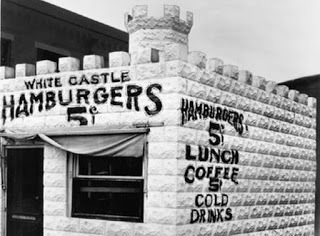 White Castle #1Since the publication of The Jungle by Upton Sinclair in 1906 exposing the unsanitary practices of the meat packing industry in Chicago, Americans were reluctant to eat ground beef. Aware of this, the White Castle founders sought to change the public's perception by stressing cleanliness in their restaurants and high quality ingredients.
White Castle #1Since the publication of The Jungle by Upton Sinclair in 1906 exposing the unsanitary practices of the meat packing industry in Chicago, Americans were reluctant to eat ground beef. Aware of this, the White Castle founders sought to change the public's perception by stressing cleanliness in their restaurants and high quality ingredients. Their earliest buildings had white enameled brick exteriors and enameled steel counters. By the 1930s, the chain's restaurants were built with prefabricated white-porcelain enameled steel exteriors and outfitted with stainless steel counters. Buildings were designed so customers could see their food being prepared by employees who had to conform to a strict dress code. White Castle produced the first disposable paper hats, napkins, and cardboard sleeves to package their product.
Their earliest buildings had white enameled brick exteriors and enameled steel counters. By the 1930s, the chain's restaurants were built with prefabricated white-porcelain enameled steel exteriors and outfitted with stainless steel counters. Buildings were designed so customers could see their food being prepared by employees who had to conform to a strict dress code. White Castle produced the first disposable paper hats, napkins, and cardboard sleeves to package their product.
Short-order cook Walter Anderson is credited with the invention of the hamburger bun and the assembly-line kitchen which replaced experienced cooks with employees who could operate the griddle with minimal training. Chain-wide standardization assured the same product and service at all their locations. Often imitated but never duplicated, numerous earlier competitors were unable to match White Castle's success.
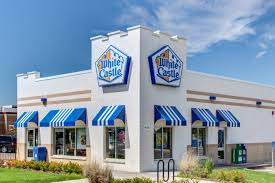 The fast-food industry we take for granted today was unknown in America before the White Castle chain. Anderson and Ingram gave rise to the fast-food phenomenon. There was no infrastructure to support their business expansion, so Anderson and Ingram established centralized bakeries, meat suppliers, branded paper manufacturing, and warehouses to supply their system's needs.
The fast-food industry we take for granted today was unknown in America before the White Castle chain. Anderson and Ingram gave rise to the fast-food phenomenon. There was no infrastructure to support their business expansion, so Anderson and Ingram established centralized bakeries, meat suppliers, branded paper manufacturing, and warehouses to supply their system's needs.In 1933, Anderson sold his half of the business to Billy Ingram. The following year, the company moved its corporate offices to Columbus, Ohio, the center of their distribution area. Ingram's business savvy is credited for the popularity of the hamburger in America.
Since the beginning, White Castle has been privately owned, and none of its restaurants are franchised. Founder Billy Ingram retired in 1958 as CEO, followed by his son E.W. Ingram Jr, and then his grandson E.W. Ingram III. In December 2015, Ingram III stepped down and his daughter Lisa Ingram became the fourth CEO of the company.
The Ingram family's refusal to franchise or take on debt throughout the company's existence has kept the chain relatively small with only about 420 outlets--all in the United States. By comparison, McDonald's has 36,000 outlets worldwide with 14,000 of those in the United States. In recent years, White Castle has been selling sliders at supermarkets nationwide.
 On January 27, 2015, White Castle opened its first outlet in the western United States at the Casino Royale Hotel on the Las Vegas Strip--the chain's first expansion into a different state in fifty-six years. On its first day of business, the restaurant had to close for two hours to restock their depleted supplies. In its first twelve hours of operation, the store sold 4,000 sliders per hour. It appears that I'm not the only one who enjoys this guilty pleasure.
On January 27, 2015, White Castle opened its first outlet in the western United States at the Casino Royale Hotel on the Las Vegas Strip--the chain's first expansion into a different state in fifty-six years. On its first day of business, the restaurant had to close for two hours to restock their depleted supplies. In its first twelve hours of operation, the store sold 4,000 sliders per hour. It appears that I'm not the only one who enjoys this guilty pleasure.Delray, Detroit and O-So Pop: https://fornology.blogspot.com/2014/08/detroits-ghost-town-delray-and-o-so.html
Published on July 01, 2018 06:09
June 19, 2018
Amazon Giveaway of Richard Streicher Jr. True Crime
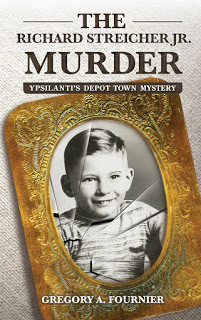 Today, June 19th, is the official publishing date of The Richard Streicher Jr. Murder: Ypsilanti's Depot Town Mystery. As part of my book launch, five free copies are available this week through an Amazon Giveaway until June 26th. Click on the link below to enter.
Today, June 19th, is the official publishing date of The Richard Streicher Jr. Murder: Ypsilanti's Depot Town Mystery. As part of my book launch, five free copies are available this week through an Amazon Giveaway until June 26th. Click on the link below to enter.Here is my book blurb:
During the depths of the Great Depression in Ypsilanti, Michigan, a seven-year-old boy is found frozen to death under the Frog Island Footbridge in Depot Town after being reported missing the night before by his parents.
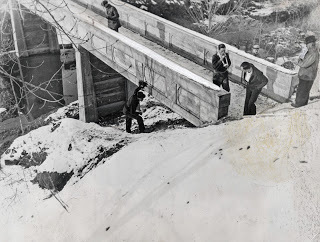 The Frog Island Footbridge where the body was found.Upon closer examination, the coroner discovers the child was the victim of foul play. Local gossips and some police were convinced they knew who the guilty party was--but proving it in a court of law was a different matter.
The Frog Island Footbridge where the body was found.Upon closer examination, the coroner discovers the child was the victim of foul play. Local gossips and some police were convinced they knew who the guilty party was--but proving it in a court of law was a different matter.Good luck! https://giveaway.amazon.com/p/ffc12b6c3646118e
Published on June 19, 2018 16:47
June 14, 2018
"Richard Streicher Jr. Murder" Book Reveal
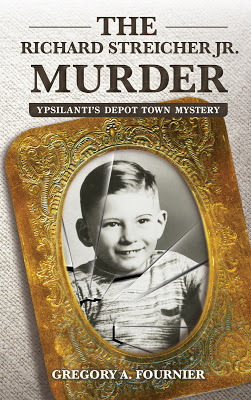 During the depths of the Great Depression in Ypsilanti, Michigan, a seven-year-old boy is found frozen to death under the Frog Island Footbridge in Depot Town after being reported missing the night before by his parents.
During the depths of the Great Depression in Ypsilanti, Michigan, a seven-year-old boy is found frozen to death under the Frog Island Footbridge in Depot Town after being reported missing the night before by his parents.Upon closer examination, the Washtenaw County Coroner discovered the child was the victim of foul play. Local gossips and some police were convinced they knew who the guilty party was, but proving it in a court of law was a different matter.
At the behest of the Ypsilanti Historical Society and through the research efforts of docents George Ridenour and Lyle McDermott, I bring you the true story of this notorious Ypsilanti murder mostly forgotten for over eighty years.
The paperback is available online through Amazon and B&N, and soon on all five digital ebook formats. Link to Amazon site: https://www.amazon.com/s/ref=nb_sb_noss?url=search-alias%3Dstripbooks&field-keywords=Richard+Streicher+Jr+Murder
Published on June 14, 2018 13:23
June 4, 2018
Allen Park Wrestler Lou Klein and Protege Heather Feather
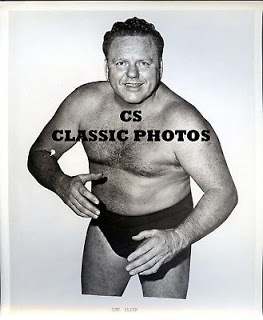 Lou KleinAllen Park, Michigan resident Lou Klein began his pro-wrestling career in 1941 after dominating the Michigan amateur ranks and earning four national titles. In the beginning of his pro-career, Kline donned a mask and wrestled as the Green Hornet so he could earn a living while protecting his amateur standing. For a time, he wrestled with Red Bastien in a tag team, but most of his career he worked as a single performer known to be a "scientific" wrestler. Early on, Klein's tag line was "The Atomic Blond from Detroit" and later in his career "The Man of a Thousand Holds." His signature finish moves were the Boston Crab and the Atomic Drop. After thirty-six years of competing in the squared circle, Klein retired on July 9, 1977.
Lou KleinAllen Park, Michigan resident Lou Klein began his pro-wrestling career in 1941 after dominating the Michigan amateur ranks and earning four national titles. In the beginning of his pro-career, Kline donned a mask and wrestled as the Green Hornet so he could earn a living while protecting his amateur standing. For a time, he wrestled with Red Bastien in a tag team, but most of his career he worked as a single performer known to be a "scientific" wrestler. Early on, Klein's tag line was "The Atomic Blond from Detroit" and later in his career "The Man of a Thousand Holds." His signature finish moves were the Boston Crab and the Atomic Drop. After thirty-six years of competing in the squared circle, Klein retired on July 9, 1977.Later in his career, Kline was known as a developer and promoter of new talent which he would manage into the professional ranks. In the 1960s, Klein leased a vacant building which had been the Allen Park Poultry Company where you could buy a live chicken and have it butchered. Kline converted the space into a wrestling school with a workout gym. In addition to teaching wrestling holds, and counter holds, he prepared new-comers for the professional ranks and pro-wrestling's secret code of Kayfabe--the representation of a staged event as genuine and authentic.
Kayfabe required wrestlers to stay in character in the ring and in public and not give away trade secrets. Kayfabe can be considered a verbal non-disclosure agreement. This three-syllable word is a Pig Latin carny term for "Be Fake" spelled backwards. If anyone came backstage who wasn't in the business for example, security or someone else would shout out "Kayfabe!" and the alert would travel through the ranks. Then, the wrestlers would put on their game faces for the press or whomever the interloper was.
In addition to his gym and wrestling school, Klein owned the local Tastee Freeze on Allen Road. Occasionally in the summer, Klein would set up a ring outside next to his gym or ice cream shop and let the kids play on it. Klein and some of his wrestling cohorts would teach the guys some grappling moves. My Allen Park High School friends Mick Osman and Earl Rennie made pocket money helping set up the ring for local promotions. Jack Ulrich remembers setting up and breaking down rings for Klein in Kingston, Ontario, Canada.
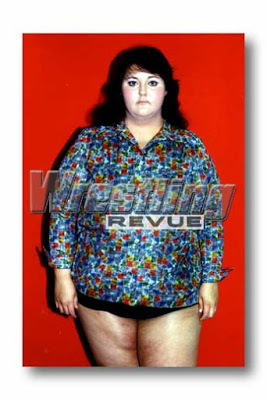 Heather FeatherOne of Lou Kline's proteges was Allen Park resident Peggy Jones. He first met Peggy when she was working the counter at the Thunderbowl bowling alley. At 5' 10" and weighing over 300#, Peggy always stood out from the crowd at North Junior High and suffered more than her share of verbal abuse and body shaming. Kline approached her about coming to the gym and begin training for a possible new career.
Heather FeatherOne of Lou Kline's proteges was Allen Park resident Peggy Jones. He first met Peggy when she was working the counter at the Thunderbowl bowling alley. At 5' 10" and weighing over 300#, Peggy always stood out from the crowd at North Junior High and suffered more than her share of verbal abuse and body shaming. Kline approached her about coming to the gym and begin training for a possible new career.She did and four months later, Kline--acting as Peggy's manager--introduced her to Big Time Wrestling promoter Eddie (The Sheik) Farhat. What Peggy lacked in speed and wrestling prowess, she made up in bulk and strength. But there were two things Peggy needed to go pro--a gimmick and a stage name.
For a gimmick, Farhat had Peggy primarily wrestle men as a parody of feminism and the growing woman's equal rights movement of the 1970s. For a stage name, Farhat came up with Heather Feather. She wrestled throughout the Midwest, but Detroit was her home base. Feather would hang ringside during a bout and taunt the male wrestlers trying to shame them into a match. Then in an unscheduled ringside interview with the announcer, she would amplify her challenge making the men look weak and cowardly. The crowd loved it. Heather Feather was the first woman to wrestle and pin a man and soon became a fan favorite.
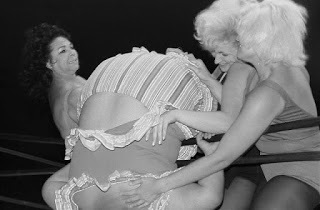 The Fabulous Moola and her crew.Her debut match was an eight-woman Battle Royale in Detroit at Cobo Hall. Several of the lady wrestlers with great effort threw the newcomer into the front row seats. Heather Feather was the first woman eliminated that night. Peggy was black and blue for her pains, but she was $200 richer. Her tenure lasted five years from 1973 until 1978.
The Fabulous Moola and her crew.Her debut match was an eight-woman Battle Royale in Detroit at Cobo Hall. Several of the lady wrestlers with great effort threw the newcomer into the front row seats. Heather Feather was the first woman eliminated that night. Peggy was black and blue for her pains, but she was $200 richer. Her tenure lasted five years from 1973 until 1978. Toward the end of her career, Feather wrestled an eight-foot-tall bear in an interspecies match. Victor, the bear, was found as an orphan cub and rescued. Pro-wrestler Tuffy Truesdell purchased the bear and trained him to wrestle humans. Victor wore a muzzle and was declawed. Truesdell and Victor toured the wrestling circuit as a novelty act. The bear was undefeated by over 100 men but could only get a draw against Feather. Once again, she bested the men but left the bear's undefeated record intact.
Heather Feather was one of the featured wrestlers in a wrestling mockumentary called I Like to Hurt People. In a rare break from the Kayfabe code of silence, the film's host Dr. Sonia Freidman asked Feather, "What's a nice twenty-three-year-old-girl doing in this racket?"
Out of character, Peggy answered, "It's really kinda hard to say. There are lots of reasons why I'm in it. Mainly it's a way of proving myself. A way of making me something in life. Have you ever met a girl built like Rosie Grier (famous 1960s football player)? I've been this tall and this weight since I was twelve. I won't lie, it was tough growing up."
When Dr. Freidman asked Feather how long she thought she would last in her chosen profession, she answered truthfully, "A girl can only last as long as she looks young. As soon as she starts looking old, she's done for. A man can do this until he drops dead in the ring." It wasn't long after this candid interview that Heather Feather was released from her wrestling contract. Kayfabe had been violated.
https://fornology.blogspot.com/2018/05/detroits-wrestling-titans.html
Published on June 04, 2018 04:51
May 29, 2018
Detroit's Wrestling Titans
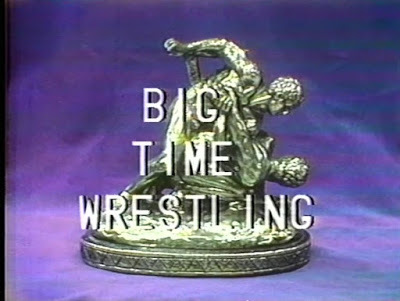
If you grew up in Detroit in the 1950s and 1960s, chances are you remember Big Time Wrestling (BTW) on WXYZ--Channel 7 which aired on Saturday's at 3:30 pm until 4:30 pm with announcer Fred Wolfe. BTW captured the rough and tumble world of Detroit's blue collar angst. Detroit wrestling fans had a strong work ethic, respect for fair play, and a hatred for dirty tactics and cheating. They particularly loved grudge matches and wars of attrition which could last twenty minutes of more. BTW wrestlers were not pretty boys from the West Coast or elite snobs from the East Coast--they were blue collar heroes who had to work for a living.
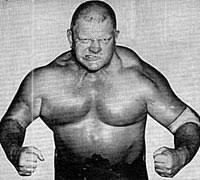 Dick, the BruiserEarly wrestling story lines involved coastal invaders coming into our town bragging how tough they were. They would abuse and destroy our mid-level wrestlers trying to climb the ranks and then they would turn and insult the crowd proclaiming Motor City wrestlers weren't that tough. Then a month or so later, these sore winners would return to wrestle our top guys and get their clocks cleaned. A notable exception to this rule was the most hated New York wrestler in the business--Dick, the Bruiser. He beat the Hell out of everyone. In and out of the ring.
Dick, the BruiserEarly wrestling story lines involved coastal invaders coming into our town bragging how tough they were. They would abuse and destroy our mid-level wrestlers trying to climb the ranks and then they would turn and insult the crowd proclaiming Motor City wrestlers weren't that tough. Then a month or so later, these sore winners would return to wrestle our top guys and get their clocks cleaned. A notable exception to this rule was the most hated New York wrestler in the business--Dick, the Bruiser. He beat the Hell out of everyone. In and out of the ring.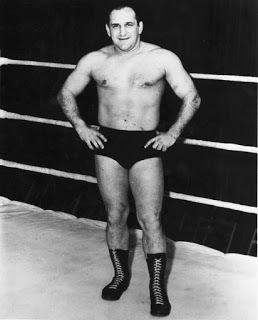 Leaping Larry Chene (not Shane)Some of Detroit's fan favorites were Lou Kline--the Man of a Thousand Moves, Dick "Mr. Michigan" Garza, Haystack Calhoun, Bobo Brazil, Ernie Ladd, Killer Kowalski, George "The Animal" Steele, the Junkyard Dog, and my favorite Leaping Larry Chene.
Leaping Larry Chene (not Shane)Some of Detroit's fan favorites were Lou Kline--the Man of a Thousand Moves, Dick "Mr. Michigan" Garza, Haystack Calhoun, Bobo Brazil, Ernie Ladd, Killer Kowalski, George "The Animal" Steele, the Junkyard Dog, and my favorite Leaping Larry Chene.Chene (Arthur Lawrence Beauchene) was tragically killed at the age of thirty-five in an early morning car accident on October 2, 1964 while returning home to Michigan from a match in Moline, Illinois the previous night. Leaping Larry Chene was a credit to his profession and sorely missed by his fans.
That same year, Edward Farhat and his father-in-law bought the BTW television rights and secured exclusive rights to promote wrestling events at Cobo Arena for a mere $50,000. Edward Farhat, better known as The Sheik, was the most hated wrestler in Detroit. Farhat's character usually came out dressed in a robe and an Arab headress. He wore wrestling shoes with exaggerated pointed toes and had a camel printed on his wrestling shorts. The Sheik was the focus of Detroit's growing frustration with the Middle East, and he did everything he could but set a Ford Pinto on fire in the middle of the squared circle to incite the crowd.
 Rocky Johnson is Dwayne "The Rock" Johnson's father.The Sheik's signature move was the Camel Clutch, but he was also known for "blinding" his opponents with his patented magic fire ball effect. Once his opponent were disoriented, The Sheik would attack him mercilessly and stretch him out for a win. Usually, medics stood by to roll the loser out of the arena on a gurney while the crowd gave the man a howling ovation. As a kid, I was mesmerized by the fireball. A few years later, I discovered that magician's flash paper could be purchased at any magic or novelty shop in town.
Rocky Johnson is Dwayne "The Rock" Johnson's father.The Sheik's signature move was the Camel Clutch, but he was also known for "blinding" his opponents with his patented magic fire ball effect. Once his opponent were disoriented, The Sheik would attack him mercilessly and stretch him out for a win. Usually, medics stood by to roll the loser out of the arena on a gurney while the crowd gave the man a howling ovation. As a kid, I was mesmerized by the fireball. A few years later, I discovered that magician's flash paper could be purchased at any magic or novelty shop in town.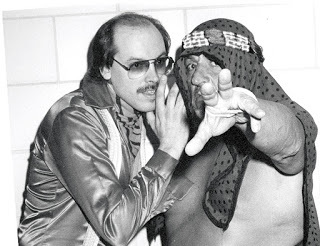 The Sheik with his manager son.Under Farhat's leadership, BTW matches suddenly became edgier and bloodier with ethnic overtones. In the 1970s and 1980s, Detroit faced the oil crisis and stiff competition from foreign competitors. Farhot imported Japanese wrestlers like Kenuke Honda and Toyota Matahashi to exploit this economic reality.
The Sheik with his manager son.Under Farhat's leadership, BTW matches suddenly became edgier and bloodier with ethnic overtones. In the 1970s and 1980s, Detroit faced the oil crisis and stiff competition from foreign competitors. Farhot imported Japanese wrestlers like Kenuke Honda and Toyota Matahashi to exploit this economic reality. The Japanese tag team worked their way up the ranks until they won the BTW title belt by throwing Sumo salt into the eyes of their opponents--shades of The Sheik's fire ball move. Then, in front of rabid Detroit fans, the Japanese wrestlers destroyed the officially sanctioned title belt and replaced it with one made in Japan. They bragged their belt was better quality and less expensive. Those were fighting words in Detroit and the new champions were led out of the arena under police protection and left the country with the belt--as the narrative went. In professional wrestling, the line between reality and fantasy gets blurred, and if you can get the crowd fired up, that's money in the bank.
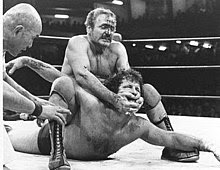 The Camel ClutchWhen the national economy went belly up in 1980, BTW could no longer draw big crowds to fill Cobo Arena or other big venues in the Midwest. The advent of cable TV and two national wrestling federations--one out of Stamford, Connecticut and the other out of Atlanta, Georgia--helped spell the death knell for regional promotions. Professional wrestling went dark in Detroit.
The Camel ClutchWhen the national economy went belly up in 1980, BTW could no longer draw big crowds to fill Cobo Arena or other big venues in the Midwest. The advent of cable TV and two national wrestling federations--one out of Stamford, Connecticut and the other out of Atlanta, Georgia--helped spell the death knell for regional promotions. Professional wrestling went dark in Detroit.Alex Karris meets Dick, the Bruiser at Lindell's AC sports bar: https://fornology.blogspot.com/2017/02/alex-karras-and-dick-bruisers-detroit.html
Published on May 29, 2018 06:27
May 21, 2018
The "Cure" for Hysterical Women Behind Asylum Walls
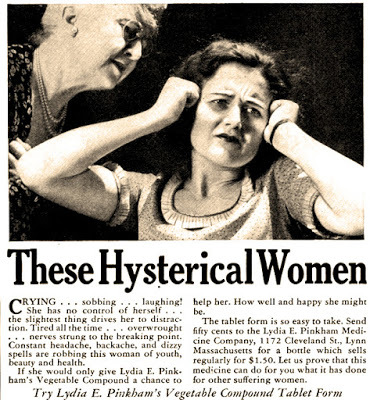 Life Magazine advertisement from August 22, 1912.
Life Magazine advertisement from August 22, 1912.The concept of the "weaker sex" in the 1800s made women more susceptible to charges of mental illness or emotional breakdown. Before the mid-1800s, women who suffered from depression or mental illness were believed to have an incurable disease of the soul. Many of these women were sent to institutions popularly known as the mad house, the insane asylum, or the nut house. Some were undoubtedly sent to local parish priests for exorcisms.
Because of existing gender stereotypes and a patriarchal society, women who disagreed with their husbands or families could be committed without formal legal proceedings or medical exigency. Institutional records indicate that women were labeled mentally ill and committed at a much higher rate than their male counterparts.
Biddy Hughes was Michigan's Eloise Asylum's first official mental patient. She was committed by her family in 1841 when she was in her mid-thirties. She was kept behind locked doors until her death fifty-eight years later.
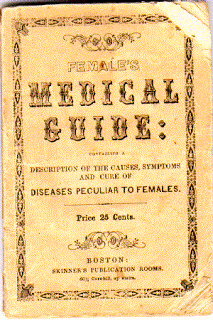 Being a woman in the nineteenth century would make any woman hysterical--a collective term then used to describe all manner of women's mental health issues--ranging from menstruation-related issues, pregnancy-related issues, post-partum depression, chronic fatigue, and anxiety. The word hysteria derives from the Ancient Greek word for womb--thus womb disease.
Being a woman in the nineteenth century would make any woman hysterical--a collective term then used to describe all manner of women's mental health issues--ranging from menstruation-related issues, pregnancy-related issues, post-partum depression, chronic fatigue, and anxiety. The word hysteria derives from the Ancient Greek word for womb--thus womb disease.Asylums were essentially warehouses for non compliant women. Once committed, these unfortunate women were subjected to a daily life of neglect and abuse. These indignities only drove troubled women deeper into mental illness regardless of why they were there. Insane asylums were not places for treatment or cure of the mentally ill.

Women had no voice to protest nor did they have any advocacy beyond the asylum gates. They lacked the solidarity to stand up for themselves or each other. Once admitted, it was next to impossible to be discharged. Bad treatment by attendants and terrible living conditions led to many asylum suicides from constant harassment, violence, loneliness, and despair.
In the Victorian age, the perfect wife did not demand time or rights for herself. She was supposed to be subservient to the needs of her family. Her husband in particular. Women with strong personalities and active minds could never conform to that role without sacrificing the core of their beings. Unsatisfied and vindictive husbands could have their wives committed for stepping outside the boundaries of her role as a wife.
Married women were sent to asylums for nymphomania, promiscuity, bearing an illegitimate child, or being the victim of rape. Women who practiced sex outside of marriage were accused of moral imbecility and could be committed for the public good. Many husbands used commitment as a convenient alternative to divorce.
By the mid-nineteenth century, doctors began regarding mental illness as a medical problem. With little formal training, they tested their quack theories on mentally ill patients. Perhaps the most egregious example of a gratuitous treatment was devised by male doctors who created a condition they called Hysterical Paroxysm.
Doctors would give female patients "pelvic massages" to release the women's pent-up libido and frustrations. It wasn't long before women were being treated for frustration and anxiety as outpatients in doctors' offices. After the electric vibrator was invented towards the end of the century, women could effect this treatment in the privacy of their own homes.
 Doctors of this era believed women who tried to improve their station in life by asserting their independence, getting an education, or living outside the family unit without a husband were considered suspect. Women who were outspoken, volatile, or expressed discontent were labeled mad if they refused to fit the stereotypical mold of the passive housewife. Many women were driven to mental illness by the rigid strictures polite society imposed upon them.
Doctors of this era believed women who tried to improve their station in life by asserting their independence, getting an education, or living outside the family unit without a husband were considered suspect. Women who were outspoken, volatile, or expressed discontent were labeled mad if they refused to fit the stereotypical mold of the passive housewife. Many women were driven to mental illness by the rigid strictures polite society imposed upon them.Mental health researchers in the Victorian age devised three archetypes of the mad woman:
The Ophelia (named after the heroine in Hamlet). These women were pliant and pleasant--code words for easy to control.The Crazy Jane. These patients represented psychotic women who were clearly disturbed and needed to be watched.The Lucia (named after Renaissance poisoner Lucretia Borgia). These patients were prone to violence and considered dangerous.
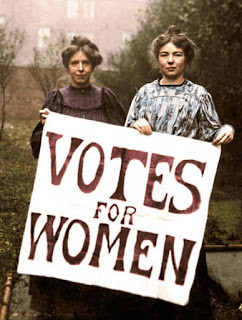 Imposing these labels on women was a way for men to garner further control over women and possess them more thoroughly. Doctors of the day warned against any activity that might change a woman's domestic status. Suffragettes and women's rights advocates were particularly troublesome for the status quo and challenged the system.
Imposing these labels on women was a way for men to garner further control over women and possess them more thoroughly. Doctors of the day warned against any activity that might change a woman's domestic status. Suffragettes and women's rights advocates were particularly troublesome for the status quo and challenged the system.Meanwhile, Edith Lanchester was committed in 1895 by her brother for refusing to marry. She was diagnosed as insane by reason of "over-education" while her brother took full possession and ownership of their jointly inherited estate.
"When We Called the Insane Asylum Eloise" link:
https://fornology.blogspot.com/2018/05/when-we-called-insane-asylum-eloise.html
Published on May 21, 2018 06:12



